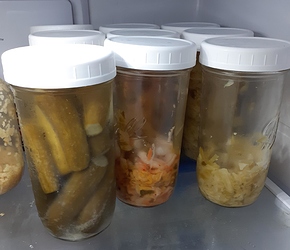I’m trying these:
http://www.herbangardener.com/2009/11/15/make-your-own-bubbies-pickles/
I also realize that I need a much larger pickling container for pickles, as the cucumbers we’re getting from our plants are fairly big. A 3 quart jar only holds about 4 cucumbers. Yikes!
My wife got me a fermenting kit for my birthday. This includes weights and cap tops to allow air out but not in. It also includes a wood tamper. It comes with a small book, with a few recipes. Pickles, sauerkraut, Giardiniera, that’s about it. Those are my next fermentation projects.
After that, I’ll get fancier.


 It makes sense that you’d want the fermenting, if that’s the deal. We would indeed cut the salt down some, next time.
It makes sense that you’d want the fermenting, if that’s the deal. We would indeed cut the salt down some, next time.

